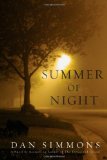Many of us have fond memories of childhood, especially those lazy summers when schools were out, the days were hot, and the neighborhoods were ripe for exploration with friends. Hugo award-winning author Dan Simmons captures this age of innocence perfectly in Summer of Night, but then he lets the monsters loose in this old school horror story about how the carefree lives of a group of children are quickly torn from them as they confront their ultimate nightmares.
The life-affirming story in Summer of Night reminds me of Stephen King’s It, as well as his short story “The Body,” in that all three stories depict youthful innocence corrupted by unspeakable terrors. In Summer of Night, a group of children in the quiet small town of Elm Haven, Illinois, discover a growing evil in the shuttered Old Central School. The children try to enlist help from their parents and other adults, but the adults ignore the children whom are, from the adults’ point of view, just being foolish and making things up. So the children band together in order to defeat the evil themselves, before the ancient horror engulfs the town and enslaves the world in a reign of terror.
Simmons takes his time to build up the tension and horror in the book, detailing the lives and thoughts of the kids in this everyday midwestern town. In fact, these details are what gives depth to the story. Some critics criticize “genre” stories for lacking characterization at the expense of plot. Simmons mutes this criticism by developing the characters and their motivations in the story so that the reader really cares for them and perhaps even relives childhood memories through the romps of these children as they pursue their summer freedoms to the fullest. This character development is also devastating, however, for when Simmons unleashes the monsters on these characters the reader has come to know and love, the horror is gruesomely effective. This is a horror story the way horror stories should be written.
One interesting fact relates to another of Dan Simmons’ books, Children of the Night, winner of the 1993 Locus Award for Best Horror/Dark Fantasy Novel. In that novel, the story focuses on an American hematologist named Kate Neuman, a dying baby she adopts during a visit to Romania, and a priest named Mike O’Rourke, who helps her get out of that post-Communist country while being chased by Vlad Dracula himself. That priest, Mike O’Rourke, is the same Mike from Summer of Night, just much older, making Children of the Night a loose sequel to Summer of Night.
I particularly enjoyed Simmons’ ability to develop sympathetic characters. I think that especially in horror stories, if the reader is invested in a character, they will likely also “feel” the horror more fully. I also appreciated the author’s attention to detail. The small midwestern town was a believable place and the characters seemed almost like real people. But the author also used other details effectively, such as developing a complex history of a mysterious bell, which almost becomes a character itself, as well as using words and ways of speaking authentic to the time period depicted. For example, a diary entry from 1917 used the term “social intercourse”—an awkward term not in common use today (which means simply “communication between individuals”) but one contextually authentic for the diary.
Simmons knows how to write, how to entertain, and how to give the reader the creeps. All three of these skills are expertly demonstrated in Summer of Night, so pick up the book, listen for the long-silent bell as it rings the doom of Elm Haven, and journey with the children as they fight unsightly terrors that threaten humanity itself.
